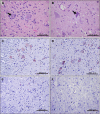Pathogenesis of Modoc virus (Flaviviridae; Flavivirus) in persistently infected hamsters
- PMID: 23358636
- PMCID: PMC3592524
- DOI: 10.4269/ajtmh.12-0110
Pathogenesis of Modoc virus (Flaviviridae; Flavivirus) in persistently infected hamsters
Abstract
The long-term persistence of Modoc virus (MODV) infection was investigated in a hamster model. Golden hamsters (Mesocricetus auratus) were infected by subcutaneous inoculation with MODV, in which fatal encephalitis developed in 12.5% (2 of 16). Surviving hamsters shed infectious MODV in their urine during the first five months after infection, and infectious MODV was recovered by co-cultivation of kidney tissue up to eight months after infection. There were no histopathologic changes observed in the kidneys despite detection of viral antigen for 250 days after infection. Mild inflammation and neuronal degeneration in the central nervous system were the primary lesions observed during early infection. These findings confirm previous reports of persistent flavivirus infection in animals and suggest a mechanism for the maintenance of MODV in nature.
Figures


Similar articles
-
Persistent West Nile virus infection in the golden hamster: studies on its mechanism and possible implications for other flavivirus infections.J Infect Dis. 2005 Jul 15;192(2):287-95. doi: 10.1086/431153. Epub 2005 Jun 13. J Infect Dis. 2005. PMID: 15962223
-
Persistence of experimental Rocio virus infection in the golden hamster (Mesocricetus auratus).Mem Inst Oswaldo Cruz. 2012 Aug;107(5):630-6. doi: 10.1590/s0074-02762012000500009. Mem Inst Oswaldo Cruz. 2012. PMID: 22850953
-
Chronic St. Louis encephalitis virus infection in the golden hamster (Mesocricetus auratus).Am J Trop Med Hyg. 2007 Feb;76(2):299-306. Am J Trop Med Hyg. 2007. PMID: 17297039
-
Mouse and hamster models for the study of therapy against flavivirus infections.Novartis Found Symp. 2006;277:218-29; discussion 229-32, 251-3. Novartis Found Symp. 2006. PMID: 17319165 Review.
-
Astrocytes in Flavivirus Infections.Int J Mol Sci. 2019 Feb 6;20(3):691. doi: 10.3390/ijms20030691. Int J Mol Sci. 2019. PMID: 30736273 Free PMC article. Review.
Cited by
-
A Review of Flaviviruses that Have No Known Arthropod Vector.Viruses. 2017 Jun 21;9(6):154. doi: 10.3390/v9060154. Viruses. 2017. PMID: 28635667 Free PMC article. Review.
-
Exploratory re-encoding of yellow fever virus genome: new insights for the design of live-attenuated viruses.Virus Evol. 2018 Jul 23;4(2):vey021. doi: 10.1093/ve/vey021. eCollection 2018 Jul. Virus Evol. 2018. PMID: 30057792 Free PMC article.
-
Insect-specific flaviviruses: a systematic review of their discovery, host range, mode of transmission, superinfection exclusion potential and genomic organization.Viruses. 2015 Apr 10;7(4):1927-59. doi: 10.3390/v7041927. Viruses. 2015. PMID: 25866904 Free PMC article.
-
Full-Genome Characterization and Genetic Evolution of West African Isolates of Bagaza Virus.Viruses. 2018 Apr 13;10(4):193. doi: 10.3390/v10040193. Viruses. 2018. PMID: 29652824 Free PMC article.
-
Increased Ifng and Il10 Expression Correlate with Disease in Rodent Models Experimentally Infected with Modoc Virus.Viruses. 2022 May 11;14(5):1026. doi: 10.3390/v14051026. Viruses. 2022. PMID: 35632766 Free PMC article.
References
-
- Johnson HN. Ecological implications of antigenically related mammalian viruses for which arthropod vectors are unknown and avian-associated soft tick viruses. Jpn J Med Sci Biol. 1967;20:160–166. - PubMed
-
- Karabatsos N. International Catalogue of Arboviruses Including Certain Other Viruses of Vertebrates. Third edition. San Antonio, TX: American Society of Tropical Medicine and Hygiene; 1984. pp. 691–692. - PubMed
-
- Zarnke RL, Yuill TM. Modoc-like virus isolated from wild deer mice (Peromyscus maniculatus) J Wildl Dis. 1985;21:94–99. - PubMed
-
- Fairbrother A, Yuill TM. Experimental infection and horizontal transmission of Modoc virus in deer mice (Peromyscus maniculatus) J Wildl Dis. 1987;23:179–185. - PubMed
Publication types
MeSH terms
Substances
Grants and funding
LinkOut - more resources
Full Text Sources
Other Literature Sources

